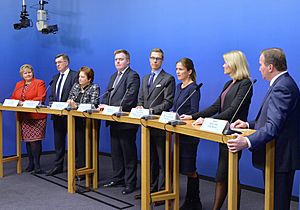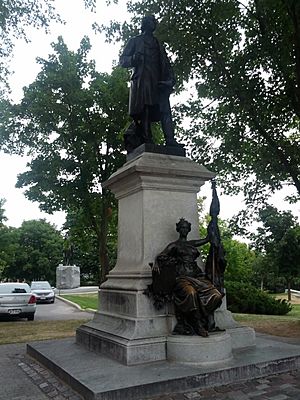Prime minister facts for kids

A prime minister is a very important leader in a country's government. They are usually the head of the cabinet, which is a group of top ministers. These ministers help run the country's executive branch. This role is common in countries that use a parliamentary or semi-presidential system.
A prime minister is not the head of state, like a king, queen, or president. Instead, they are the head of government. This means they are in charge of the day-to-day running of the country. They often work under a monarch or a president.
In many countries, especially those like the United Kingdom (which use the Westminster system), the prime minister is the main leader of the government. They lead the executive branch. In these systems, the head of state (like a monarch or president) often has a role that is mostly ceremonial. This means they perform official duties but don't usually make big decisions.
The prime minister often chooses the other members of the cabinet. They can also remove ministers and decide what jobs each minister will have. In most systems, the prime minister leads the cabinet meetings. In some systems, like semi-presidential systems, the prime minister is in charge of the civil service. They make sure the government's plans are carried out.
A prime minister is often a member of the country's legislature (like a parliament). They work with other ministers to help pass new laws. In some countries with a monarchy, the monarch might also have special powers. These powers are given by the country's laws and can be used without parliament's approval.
Besides being the head of government, a prime minister might have other important jobs. For example, the Prime Minister of the United Kingdom is also known as the First Lord of the Treasury. During World War II, Winston Churchill was the Prime Minister of the UK. He was also the Minister of Defence at the same time. Another example is Benjamin Netanyahu. When he was the Prime Minister of Israel between 2015 and 2019, he held several other minister roles. These included Minister of Communications and Foreign Affairs.
Countries with a Prime Minister

Many countries around the world have a prime minister as their head of government. Here are some examples:
- United Kingdom (works with a Monarch)
- Antigua and Barbuda (works with a Monarch)
- Australia (works with a Monarch)
- Azerbaijan (works with a President)
- Barbados (works with a Monarch)
- Canada (works with a Monarch)
- France (works with a President)
- India (works with a President)
- Malaysia (works with a Monarch)
- Mauritius (works with a President)
- Israel (works with a President)
- Italy (works with a President)
- Ireland (works with a President)
- Japan (works with an Emperor)
- Pakistan (works with a President)
- Romania (works with a President)
- The Netherlands (works with a Monarch)
- Singapore (works with a President)
- Thailand (works with a Monarch)
- Trinidad and Tobago (works with a President)
- Turkey (works with a President)
- Ukraine (works with a President)
- New Zealand (works with a Monarch)
Images for kids
-
Narendra Modi, the Prime Minister of India
-
Jawaharlal Nehru (1889–1964), the first Prime Minister of India
-
John A. Macdonald (1815–1891), first Canadian Prime Minister.
-
Sirimavo Bandaranaike (1916–2000), former Prime Minister of Sri Lanka and the first female Prime Minister in the world.
-
British prime minister William Pitt the Younger (1759–1806), who became head of government at just 24 years old.
See also
 In Spanish: Primer ministro para niños
In Spanish: Primer ministro para niños







